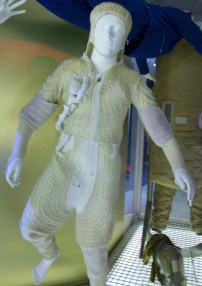January 3, 2014
One Giant Leap for Textiles
Have you passed the signs for the National Space Centre on the M1 motorway? Take the time to follow them! The Centre is a real visual and educational treat, particularly if you’re still blinking from the 3D movie special effects of Gravity. I had a rather privileged tour, as I w as there researching explorer’s gear for a new book called All Dressed Up – A History of Clothes in 30 Objects. So far I’ve explored the history of polar expedition clothes and aviator’s outfits. Now for the next frontier…
as there researching explorer’s gear for a new book called All Dressed Up – A History of Clothes in 30 Objects. So far I’ve explored the history of polar expedition clothes and aviator’s outfits. Now for the next frontier…
Where better to see spacewear than in the selection at the Space Centre? It includes pieces on loan from Britain’s first astronaut, Sheffield chemist Helen Sharman, who was selected for the 1991 Juno mission onboard Mir International Space Station.
How futuristic the space gear looks compared to the 19th C diving suits I’ve been researching. Essentially they follow similar principles – they protect the vulnerable human form in extreme environmental conditions. Spacesuits are fireproof, waterproof, airtight, ventilated. It’s no easy task to design clothes that also allow movement and communication… and facilities for basic biological processes such as breathing and waste evacuation. (I’m not sure there’s much NASA specialists can do about sneezing in one’s helmet yet.)
Not only humans are clothed – the Space Centre has a canine high-altitude pressure suit on display too – sadly outside the remit of my current book.
Spacesuits are mostly only worn with sealed helmets for take off and landing, as they are far too hot and cramped inside a space station. Helen Sharman noted that on the journey up to Mir the astronauts had to take their space suits off to dry in the command module, as  they were all rather sweaty.
they were all rather sweaty.
The human form is fully swamped inside the iconic EVA – Extra Vehicular Activity – suit, used for ‘spacewalks’ and work on the exterior of the space station. Astronauts certainly can’t get fully dressed themselves, aside from putting on the underwear layer that is looped with tubes for cooling fluid to pass round the body.
What stuck me most when I had a closer look at the Space Centre exhibits, was how crucial small costume inventions are to human exploration. Could a spacesuit be rendered airtight so easily without zips, for example? And would there be humans in space without Velcro?
For those who dismiss costume history as a frivolous topic it is worth remembering that human exploration absolutely depends on having the right gear. And spacesuits are, bizarrely, part of costume history now, from the famous Apollo 11 moon landing suits of Armstrong and Aldrin, to Helen Sharman’s snazzy blue jump suit (rumoured to be stained from a floating drop of hot chocolate while weightless). However, the phenomenally advanced fabrics of spacewear – including inventions such as Goretex, Kevlar, neoprene and polyurethane – are still subject to degradation over time. They now require the care and attention of spacesuit conservators – surely a specialist job if ever there was one. Experts at the Smithsonian National Air and Space Museum in the US are learning how to stabilise chemical processes that cause deterioration, and how to avoid light damage. In one conservation paper they do specify that “Care must be taken not to remove any historical debris or dirt, such as lunar dust.”
Extraordinary!
As technology progresses no doubt exploration clothes will push new boundaries. I look forward to learning more…
With thanks to Dan Kendall at the National Space Centre, Leicester. Also, acknowledging information from Seize the Moment – The Autobiography of Britain’s First Astronaut, Helen Sharman and Christopher Priest; and Collections Care – The Preservation, Storage, and Display of Spacesuits, Smithsonian National Air and Space Museum Report Number 5 December 2001 by Lisa A. Young and Amanda J. Young